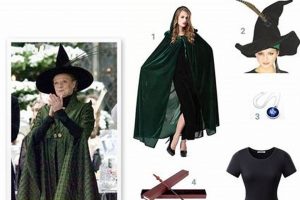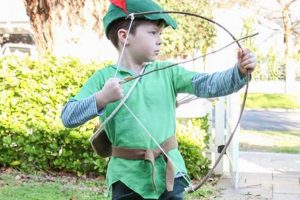The creation of period-accurate or fanciful attire for participation in reenactments or themed events, specifically those inspired by the European Renaissance, is a popular activity. These garments, often crafted at home, allow individuals to express creativity and immerse themselves in the atmosphere of a Renaissance festival. An example would be constructing a Tudor-style gown from readily available fabrics and patterns.
The significance of creating such garments lies in its accessibility and potential for personalized expression. This practice permits a high degree of customization, ensuring a unique and comfortable fit for the wearer. Furthermore, it often represents a more cost-effective alternative to purchasing commercially produced costumes, enabling broader participation in Renaissance-themed events. Historically, individuals made their own clothing out of necessity and personal preference, mirroring the resourceful spirit of past eras.
The following sections will explore various aspects of creating personalized Renaissance-inspired apparel, including material selection, basic garment construction techniques, and methods for embellishing and accessorizing to achieve a desired aesthetic.
Creating Authentic-Looking Renaissance Festival Attire
Achieving a convincing Renaissance appearance requires careful planning and attention to detail. The following tips are designed to guide the construction process and enhance the final product’s historical accuracy and aesthetic appeal.
Tip 1: Research Period Garments: Prioritize thorough investigation of Renaissance clothing styles relevant to the desired social class and time period. Examine paintings, illustrations, and extant garments (if available) for accurate representation of silhouettes, fabrics, and embellishments.
Tip 2: Select Appropriate Fabrics: Opt for natural fibers such as linen, wool, or cotton, depending on the intended garment and wearer comfort. Avoid overtly modern fabrics such as polyester or spandex, which detract from the authenticity of the costume. Weight and texture should align with historical usage.
Tip 3: Utilize Accurate Patterns: Employ patterns derived from historical sources or reputable pattern companies specializing in historical reproductions. Modify existing patterns as needed to ensure proper fit and adherence to period-correct construction techniques.
Tip 4: Emphasize Hand Sewing Techniques: Incorporate hand-sewing techniques, such as back stitch or running stitch, for seams and embellishments. Hand sewing often provides a more authentic appearance and allows for greater control over intricate details.
Tip 5: Pay Attention to Undergarments: Construct or acquire appropriate undergarments, such as chemises, corsets (if applicable), and petticoats, to provide the correct shape and support for the outer garments. The undergarments contribute significantly to the overall silhouette of the costume.
Tip 6: Accessorize Thoughtfully: Choose accessories that are consistent with the chosen time period and social status. Consider items such as belts, pouches, hats, jewelry, and footwear. Avoid anachronistic accessories that could detract from the overall impression.
Tip 7: Weather and Wear Appropriately: New fabric can appear too crisp and unnatural. Consider gentle weathering techniques, such as washing or lightly distressing the fabric, to create a more lived-in appearance. Handle the completed garment with care to avoid damage and preserve its integrity.
By implementing these strategies, individuals can improve the realism and visual impact of hand-crafted Renaissance Festival costumes, elevating their participation in reenactments and themed events. The pursuit of accuracy, even in DIY projects, yields a more immersive and rewarding experience.
The next section will explore specific garment types and construction methods relevant to achieving various Renaissance character portrayals.
1. Material selection
Material selection forms the foundation of any successful self-made Renaissance festival costume. The choice of fabrics directly impacts the authenticity, visual appeal, and overall comfort of the attire. Inaccurate material choices can detract from the intended historical impression, while thoughtful selections enhance the immersive experience.
- Fiber Content and Historical Accuracy
The fiber content of the chosen fabric directly influences its historical plausibility. Renaissance-era clothing primarily utilized natural fibers such as linen, wool, silk, and cotton (though cotton was less common in Europe until later periods). Synthetic fabrics, like polyester or rayon, are anachronistic and visibly out of place. The texture and drape of these fibers also differ significantly from natural materials, impacting the overall appearance of the costume.
- Fabric Weight and Drape
The weight and drape of the fabric affect the silhouette and movement of the garment. Heavy wools were common for outer garments like doublets and gowns, providing structure and warmth. Lighter linens and silks were used for undergarments and finer details. Selecting a fabric with the appropriate weight and drape is crucial for achieving an accurate and flattering shape. For example, using a lightweight fabric for a garment that historically required a heavier material would result in a limp and unconvincing appearance.
- Color and Dyeing Techniques
The color and dyeing techniques used to create the fabric should also be considered. Natural dyes, derived from plants and minerals, were the primary source of color during the Renaissance. While synthetic dyes offer a wider range of colors, they often lack the subtle variations and depth of natural dyes. Furthermore, certain colors were more readily available or associated with specific social classes. Careful consideration of color choices enhances the historical accuracy of the costume.
- Cost and Availability
The cost and availability of different fabrics also play a significant role in material selection. While silk might be the most historically accurate choice for certain garments, it may be prohibitively expensive for a self-made project. Linen and wool, being more affordable and readily available, often serve as practical alternatives. Balancing historical accuracy with budgetary constraints is a key consideration in the DIY process.
Therefore, the process of selecting appropriate materials is integral to the creation of convincing Renaissance-themed garments. Attention to fiber content, weight, color, and cost allows individuals to craft costumes that are both aesthetically pleasing and historically informed. The careful choice of materials elevates the project from a simple costume to a carefully crafted piece of wearable art, enhancing the overall experience of participating in Renaissance festivals and events.
2. Pattern Accuracy
The fidelity of garment patterns to historical precedents is a pivotal factor in the creation of convincing hand-made Renaissance festival attire. Deviation from accurate patterns can result in garments that, despite employing appropriate materials and construction techniques, fail to convey the intended historical aesthetic.
- Source Material Reliability
The accuracy of a pattern is directly contingent upon the reliability of its source material. Patterns derived from extant garments, museum collections, or scholarly publications generally offer a higher degree of accuracy compared to those based on conjecture or simplified interpretations. Reliance on vetted sources minimizes the introduction of inaccuracies in proportion, silhouette, and construction details. Example: A pattern based on measurements and construction details documented from a surviving Elizabethan doublet will invariably yield a more accurate reproduction than one drawn from a modern interpretation of the same garment.
- Pattern Scaling and Adaptation
Even patterns sourced from reliable historical data may require scaling and adaptation to fit contemporary body types. Accurate scaling necessitates a thorough understanding of historical sizing conventions and potential adjustments required to accommodate variations in modern physiques. Inadequate scaling can distort the garment’s proportions and detract from its authenticity. Example: Simply enlarging a historical pattern without considering the differences in shoulder width or torso length could result in a poorly fitting and unconvincing garment.
- Construction Detail Fidelity
Pattern accuracy extends beyond overall shape to encompass specific construction details. The precise placement of seams, darts, gussets, and other structural elements contributes significantly to the garment’s historical plausibility. Simplified patterns that omit these details, while potentially easier to construct, often lack the nuanced appearance of authentic Renaissance clothing. Example: Omitting the complex shaping achieved through multiple gores in a 16th-century skirt pattern results in a less voluminous and less historically accurate garment.
- Interpretation and Skill Level
The successful translation of a pattern, even an accurate one, hinges on the skill and interpretation of the individual constructing the garment. A pattern provides a blueprint, but the seamster’s ability to execute the instructions with precision and understanding of historical sewing techniques ultimately determines the final outcome. Inaccurate interpretation of pattern markings or improper sewing techniques can compromise the garment’s accuracy, irrespective of the pattern’s original integrity. Example: Misinterpreting grainline markings on a pattern piece can lead to fabric distortion and an ill-fitting garment, even if the pattern itself is historically accurate.
Therefore, a commitment to pattern accuracy constitutes an essential element in the successful creation of self-made Renaissance festival attire. The selection of reliable sources, careful scaling and adaptation, meticulous attention to construction details, and skilled execution of the pattern all contribute to the overall authenticity and visual impact of the finished garment. Prioritizing pattern accuracy enhances the immersive experience of both the wearer and the observer, elevating the project beyond a mere costume to a meticulously crafted historical representation.
3. Construction techniques
The integrity and historical accuracy of self-made Renaissance festival attire are fundamentally dependent upon the application of appropriate construction techniques. These methods, often differing significantly from modern garment construction, dictate the garment’s shape, durability, and overall aesthetic authenticity.
- Seam Finishes and Reinforcements
Historical seam finishes and reinforcements, such as flat felled seams, whip stitching, and the use of linen tape, play a crucial role in the durability and longevity of Renaissance-style garments. These techniques, while more time-consuming than modern serging, provide robust seam security and prevent fraying, particularly in garments constructed from natural fibers. For instance, a hand-felled seam on a linen doublet ensures structural integrity and prevents wear and tear during festival activities, preserving the garment’s appearance over time.
- Hand Sewing vs. Machine Sewing
The balance between hand sewing and machine sewing significantly affects the authenticity of the finished garment. While machine sewing offers efficiency, excessive reliance on it can detract from the hand-crafted aesthetic characteristic of Renaissance clothing. Strategic use of hand sewing for visible seams, embellishments, and detailing enhances the garment’s historical plausibility. For example, hand-stitched eyelets on a bodice demonstrate attention to detail and convey a sense of historical accuracy that machine-made eyelets lack.
- Interfacing and Support Structures
The use of appropriate interfacing materials and support structures is essential for achieving the correct silhouette and maintaining the shape of Renaissance-era garments. Linen canvas, buckram, and whalebone (or modern substitutes) were commonly employed to provide stiffness and support to bodices, sleeves, and other structural elements. The selection and application of these materials significantly impact the garment’s overall form and historical accuracy. A well-boned bodice, for example, provides the required support and shape for an Elizabethan gown, contributing to its regal appearance.
- Fitting and Adjustments
Accurate fitting and adjustments are paramount for ensuring a comfortable and flattering fit in hand-made Renaissance attire. Historical garments were often tailored closely to the body, requiring precise measurements and alterations. The ability to make adjustments to patterns and garments during the construction process is crucial for achieving a well-fitted and historically accurate result. Iterative fitting sessions, using a mock-up (or “muslin”), enable adjustments that accommodate individual body shapes and ensure optimal comfort and mobility within the completed garment.
In conclusion, the successful creation of do-it-yourself Renaissance festival costumes hinges upon a comprehensive understanding and application of historically appropriate construction techniques. These techniques, encompassing seam finishes, sewing methods, support structures, and fitting processes, contribute to the garment’s durability, aesthetic authenticity, and overall wearability. By prioritizing accurate construction techniques, individuals can create costumes that are not only visually appealing but also historically informed and reflective of the craftsmanship of the Renaissance era.
4. Embellishment details
Embellishment details exert a significant influence on the visual impact and perceived authenticity of self-made Renaissance festival attire. These additions, ranging from simple trims to intricate embroidery, differentiate a rudimentary garment from a convincing
historical representation. The careful selection and application of embellishments directly correlate with the overall aesthetic success of do-it-yourself Renaissance festival costumes. For example, the addition of silk ribbon and hand-stitched pearls to a plain linen bodice can elevate its appearance, transforming it from a basic undergarment into a visually striking component of a noblewoman’s ensemble. Conversely, the use of anachronistic or poorly executed embellishments can undermine the garment’s intended historical impression.
The practical application of this understanding extends to several key areas of costume construction. First, research into period-accurate embellishment techniques and materials is crucial. Examining historical paintings, extant garments, and pattern books provides valuable insights into the types of trims, embroidery designs, and decorative elements appropriate for specific social classes and time periods. Second, the selection of high-quality materials is paramount. The use of inexpensive or synthetic trims can diminish the visual appeal of the costume. Opting for natural fibers, such as silk, wool, or linen, for embellishments enhances the garment’s overall authenticity. Finally, meticulous execution of the embellishment is essential. Poorly stitched seams, uneven embroidery, or carelessly applied trims can detract from the costume’s overall impression. Practice and patience are necessary to master the skills required for creating convincing embellishments.
In summary, the effective integration of embellishment details is a critical aspect of creating successful DIY Renaissance festival costumes. While the process presents challenges in terms of research, material selection, and execution, the rewards are substantial. Thoughtful and well-executed embellishments enhance the garment’s visual appeal, contribute to its historical authenticity, and elevate the wearer’s overall experience. The attention paid to these details distinguishes a thoughtfully constructed costume from a generic garment, enriching participation in Renaissance-themed events.
5. Accessorization
The inclusion of appropriate accessories represents a critical final step in the creation of effective self-made Renaissance festival attire. Accessories serve not merely as ornamentation, but as integral components that enhance the historical plausibility and visual narrative of the costume. Omission of suitable accessories can diminish the overall impact of an otherwise meticulously constructed garment. Conversely, thoughtful selection and integration of accessories can elevate a simple costume, imbuing it with character and historical context. For example, a hand-sewn Elizabethan gown, lacking jewelry, headwear, or a proper belt, appears incomplete, failing to fully convey the intended social status and period aesthetic. The appropriate addition of a jeweled girdle, a linen coif, and a delicate ruff completes the ensemble, solidifying its historical integrity.
The range of applicable accessories extends considerably, encompassing headwear (hats, caps, veils), jewelry (necklaces, rings, brooches), belts and pouches, footwear (shoes, boots), and functional items such as fans, gloves, or writing implements. The specific accessories selected must align with the chosen social class, geographic location, and time period being represented. The deliberate choice of a leather belt with a simple pouch for a peasant costume, versus a silk sash adorned with gemstones for a noble character, effectively communicates social standing and personal narrative. Practical considerations also factor into accessorization. A well-crafted leather pouch can serve as a functional element, allowing the wearer to carry essential items discreetly while maintaining the integrity of the costume. Furthermore, the correct type of footwear is essential for navigating outdoor festival grounds comfortably and safely, while remaining period-appropriate.
In summary, accessorization is not an afterthought, but a crucial aspect of crafting impactful Renaissance festival attire. Accessories provide vital visual cues, communicate character narrative, and enhance the overall immersive experience. By focusing on accuracy, functionality, and meticulous detail in the selection and integration of these elements, individuals can transform self-made garments into convincing and compelling historical representations. Challenges, such as finding or fabricating period-appropriate accessories, can be overcome through research and resourcefulness. Thoughtful accessorization provides a culmination to the “diy renaissance festival costumes” pursuit.
6. Wearability/Comfort
Wearability and comfort represent critical, often overlooked, aspects of successfully executed self-made Renaissance festival attire. The most historically accurate and visually stunning costume loses its appeal if it proves unbearable to wear for an extended period. The inherent cause-and-effect relationship dictates that discomfort directly diminishes the overall enjoyment and participation in the event. As a result, prioritizing wearability is not merely a matter of convenience, but a fundamental component of any successful “diy renaissance festival costumes” endeavor. Real-life examples abound: a tightly laced corset, while historically accurate, can restrict breathing and movement, leading to fatigue and diminished stamina. Similarly, a heavy woolen gown, though visually impressive, can become excessively hot and uncomfortable in warm weather. The practical significance of this understanding lies in the need to balance historical accuracy with the realities of physical endurance.
Consideration of wearability extends beyond basic comfort to encompass factors such as freedom of movement, temperature regulation, and ease of maintenance. Restricted movement hinders engagement in festival activities, transforming a potentially immersive experience into an exercise in endurance. The ability to regulate body temperature is crucial for maintaining well-being in varying weather conditions. Garments constructed from breathable natural fibers, such as linen or lightweight wool, offer superior temperature regulation compared to synthetic alternatives. Ease of maintenance also factors into long-term wearability. Costumes that require extensive and delicate cleaning procedures may become impractical for frequent use. Selecting fabrics and construction techniques that facilitate relatively easy cleaning and storage enhances the overall practicality of the garment.
In conclusion, the pursuit of authentic self-made Renaissance festival costumes necessitates a careful balance between historical accuracy and pragmatic wearability. While meticulous attention to detail and adherence to period-correct construction methods are essential, prioritizing the wearer’s comfort and physical well-being is equally important. Addressing challenges related to fabric selection, garment fit, and temperature regulation allows for the creation of costumes that are not only visually impressive but also conducive to extended wear and full engagement in the festival experience. The ultimate goal is to craft attire that enhances, rather than detracts from, the immersive and enjoyable nature of Renaissance-themed events.
Frequently Asked Questions About DIY Renaissance Festival Costumes
The following questions address common concerns and misconceptions regarding the creation of self-made Renaissance festival attire. The answers provide guidance based on historical acc
uracy, practical considerations, and cost-effectiveness.
Question 1: Are synthetic fabrics entirely unacceptable for Renaissance costumes?
While natural fibers are generally preferred for historical authenticity, judicious use of some synthetics may be acceptable for linings or reinforcement, provided they are not visible and do not compromise the overall aesthetic. However, exterior garments should primarily utilize linen, wool, or cotton where appropriate.
Question 2: How can pattern accuracy be ensured without access to museum collections?
Reputable pattern companies specializing in historical reproductions offer extensively researched patterns. Scholarly publications detailing extant garments and construction techniques also provide valuable resources for pattern development. Cross-referencing multiple sources is recommended.
Question 3: What is the most cost-effective method for acquiring historically accurate fabrics?
Linen and cotton, while not always the most luxurious options, provide a balance of historical accuracy and affordability. Sourcing fabrics from online retailers or fabric remnants can also reduce costs. Careful planning and thriftiness are essential.
Question 4: Is hand sewing absolutely necessary for a convincing Renaissance costume?
While complete hand sewing is ideal for achieving maximum authenticity, strategic use of hand sewing for visible seams and embellishments can significantly enhance the costume’s appearance. Machine sewing can be employed for less visible areas to save time.
Question 5: How can comfort be maximized in historically restrictive garments, such as corsets?
Proper fit is crucial. Constructing a corset that conforms accurately to the wearer’s measurements minimizes discomfort. Gradual wearing and conditioning of the corset also improve comfort over time. Looser lacing is acceptable for prolonged wear at festivals.
Question 6: What are the most essential accessories for completing a Renaissance costume?
Headwear (caps, hats, veils), belts and pouches, and appropriate footwear are fundamental accessories that significantly enhance the overall impression. Jewelry and other embellishments can be added to further refine the character’s portrayal.
In summary, the creation of self-made Renaissance festival attire requires a thoughtful approach that balances historical accuracy with practical considerations. By addressing these common questions and concerns, individuals can craft costumes that are both visually appealing and comfortable to wear.
The following section will explore the resources available for undertaking such projects.
DIY Renaissance Festival Costumes
This exploration of “diy renaissance festival costumes” has underscored the multifaceted nature of creating convincing historical attire. The process demands meticulous attention to detail, encompassing material selection, pattern accuracy, construction techniques, embellishment, accessorization, and wearer comfort. Each element contributes to the overall authenticity and visual impact of the finished product.
The pursuit of accurate and personalized Renaissance-inspired garments represents a commitment to both historical understanding and individual expression. Continued exploration of historical sources, refinement of craft skills, and a willingness to embrace the challenges inherent in the process will undoubtedly enhance the quality and immersive experience of future self-made Renaissance festival costumes.







![Easy DIY Police Costumes: Tips & Ideas [Budget-Friendly] The DIY Hub: Creative Crafts, Repairs & Life Hacks Easy DIY Police Costumes: Tips & Ideas [Budget-Friendly] | The DIY Hub: Creative Crafts, Repairs & Life Hacks](https://craftingdiycenter.com/wp-content/uploads/2025/07/th-7319-300x200.jpg)